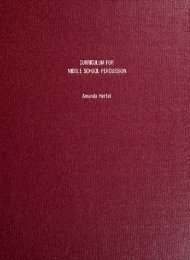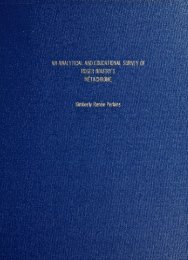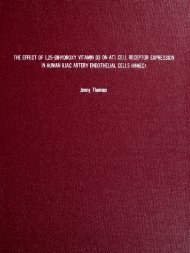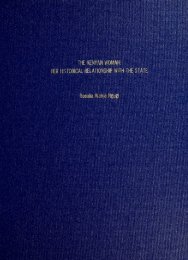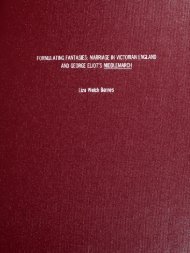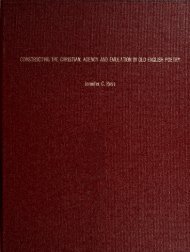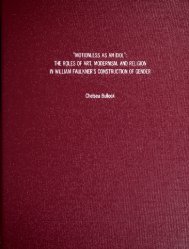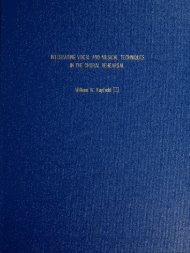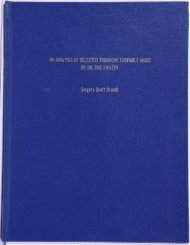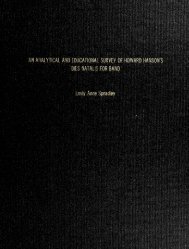k-Dependence and Domination in Kings Graphs - Columbus State ...
k-Dependence and Domination in Kings Graphs - Columbus State ...
k-Dependence and Domination in Kings Graphs - Columbus State ...
Create successful ePaper yourself
Turn your PDF publications into a flip-book with our unique Google optimized e-Paper software.
k-<strong>Dependence</strong> <strong>and</strong> <strong>Dom<strong>in</strong>ation</strong> <strong>in</strong> K<strong>in</strong>gs <strong>Graphs</strong>Author(s): Eugen J. Ionascu, Dan Pritik<strong>in</strong> <strong>and</strong> Stephen E. WrightSource: The American Mathematical Monthly, Vol. 115, No. 9 (Nov., 2008), pp. 820-836Published by: Mathematical Association of AmericaStable URL: http://www.jstor.org/stable/27642610 .Accessed: 21/08/2013 09:53Your use of the JSTOR archive <strong>in</strong>dicates your acceptance of the Terms & Conditions of Use, available at .http://www.jstor.org/page/<strong>in</strong>fo/about/policies/terms.jsp.JSTOR is a not-for-profit service that helps scholars, researchers, <strong>and</strong> students discover, use, <strong>and</strong> build upon a wide range ofcontent <strong>in</strong> a trusted digital archive. We use <strong>in</strong>formation technology <strong>and</strong> tools to <strong>in</strong>crease productivity <strong>and</strong> facilitate new formsof scholarship. For more <strong>in</strong>formation about JSTOR, please contact support@jstor.org..Mathematical Association of America is collaborat<strong>in</strong>g with JSTOR to digitize, preserve <strong>and</strong> extend access toThe American Mathematical Monthly.http://www.jstor.orgThis content downloaded from 168.26.207.10 on Wed, 21 Aug 2013 09:53:56 AMAll use subject to JSTOR Terms <strong>and</strong> Conditions
^-<strong>Dependence</strong> <strong>and</strong> <strong>Dom<strong>in</strong>ation</strong><strong>in</strong> K<strong>in</strong>gs <strong>Graphs</strong>*Eugen J. Ionascu, Dan Pritik<strong>in</strong>, <strong>and</strong> Stephen E. Wright1. INTRODUCTION. Among comb<strong>in</strong>atorial chessboard problems, the follow<strong>in</strong>g[16] is one of the most basic:What is the maximum number of k<strong>in</strong>gs that can be placedon an m x n board,so that no two squares occupied by k<strong>in</strong>gs share a side or a corner (i.e., no k<strong>in</strong>g"attacks" another)?By plac<strong>in</strong>g k<strong>in</strong>gs <strong>in</strong> row / <strong>and</strong> column j when / <strong>and</strong> j are both odd, we see that at least\m/2~\\n/2~\ squares can be occupied by k<strong>in</strong>gs. To see that this is optimal, note thatany 2x2 square can conta<strong>in</strong> at most one k<strong>in</strong>g. For m <strong>and</strong> n large,one learns that thebest one can do is to place k<strong>in</strong>gson about 1/4 of the squares. In this paper, we studythe follow<strong>in</strong>g general version of this problem:Given a whole number k < 8 (8 be<strong>in</strong>g the maximum number of squares a k<strong>in</strong>gcan attack), what is the maximum number s of k<strong>in</strong>gs that can be placedon anm x n board, so that no k<strong>in</strong>g attacks more than k other k<strong>in</strong>gs? When m <strong>and</strong> n arelarge, how large can the density s/(mn) be?For most choices of k = 0, ... , 8, there is a tidy solution: an upper bound can beproved by a short elementary argument, <strong>and</strong> an arrangement of k<strong>in</strong>gscan be constructed to show that the upper bound is tight. These limit<strong>in</strong>g densities are given <strong>in</strong>Section 6. However, tight upper bounds are not yet known for either k = 4 or k ? 5.It is easy to construct arrangements of k<strong>in</strong>gs (on arbitrarily large boards) that achievethe densities of 3/5 <strong>and</strong> 9/13 for k ? 4 <strong>and</strong> 5, respectively. We conjecture that theseare <strong>in</strong>deed the maximum limit<strong>in</strong>g densities.The story <strong>in</strong> the present article concerns the struggle to support this conjecture bygood upper bounds, as well as the variety of rival techniques used for different values of k. Along the way, we make elementaryuse of graph theory, number theory,group theory, real analysis, <strong>and</strong> <strong>in</strong>teger l<strong>in</strong>ear programm<strong>in</strong>g. We believe the methodsof the present paper can provide the basis for undergraduate research projectson related problems.2. NOTATION AND TERMINOLOGY. We have already deviated from traditionalchess <strong>in</strong> several ways: the board's length <strong>and</strong> width are arbitrary; each chess piece is ak<strong>in</strong>g with no associated color; we are concerned with optimal arrangements of pieces,rather than actual chess moves. We actually go a few steps further. First, we generalizethe discussion to address the density problem of plac<strong>in</strong>g k<strong>in</strong>gson multidimensionalchessboards. Second, it is useful to also treat toroidal boards allow<strong>in</strong>g "wrap-around";these providean idealization with the same limit<strong>in</strong>g densities as nontoroidal boards,but with a simpler analysis. Third, some results are stated <strong>in</strong> terms of arbitrary graphs.These three extensions also serve to identify possibleareas for undergraduate research.*or "Too Many K<strong>in</strong>gs <strong>and</strong> There Goesthe Neighborhood"820 ? THE MATHEMATICAL ASSOCIATION OF AMERICA [Monthly 115This content downloaded from 168.26.207.10 on Wed, 21 Aug 2013 09:53:56 AMAll use subject to JSTOR Terms <strong>and</strong> Conditions
We adopt notation <strong>and</strong> term<strong>in</strong>ology from graph theory by referr<strong>in</strong>g to board squaresas vertices. We let ... K[nx, , nd] denote the nx x x nd k<strong>in</strong>gs graphwhose vertex set is the Cartesian product [n{\ x x [nd], where [n] denotes {1,2,... , n}.Two vertices are called neighbors (or said to be adjacent) when we can get fromone to the other bya s<strong>in</strong>gle generalized k<strong>in</strong>g'smove. In other words, dist<strong>in</strong>ct vertices v = ...(t>i, , vd) <strong>and</strong> u = ...(ux, , ud) <strong>in</strong> ... K[nx, , nd]are neighborsif <strong>and</strong>only if ?\v? Ui< | 1 for each / e [d].We def<strong>in</strong>e the toroidal k<strong>in</strong>gs graph Kt0T[nx,... ,nd] on the same vertex setas K[nx,... ,nd], but consider dist<strong>in</strong>ct vertices v <strong>and</strong> u to be neighbors <strong>in</strong>Ktor[nXi? n?\ if <strong>and</strong> only if v? ? ?/ = ? 1, 0, or 1 (mod n?) for each / e [d].Theanalysisof ... ^tort^i, , nd] is muchsimplerthan that of K[n\,..., nd] becausevertices of ...Kt0T[nx, ,nd] have equally many neighbors.1Now let G be an arbitrary (loopless) graph with vertex set V(G). For a vertex v eV(G), N(\) denotes the set of vertices adjacent to v. We call N(\) the neighborhoodof v <strong>in</strong> G, not<strong>in</strong>g that N(\) does not <strong>in</strong>clude the vertex v itself. Next, consider a wholenumber k <strong>and</strong> a set S ? V(G). As <strong>in</strong>troduced by F<strong>in</strong>k <strong>and</strong> Jacobson [5], we say thatS is k-dependent <strong>in</strong> G if \N{\) n 5|< k for each v G 5, so that each vertex of S hasat most k neighbors <strong>in</strong> S. The name "/c-dependent" arises from the case k = 0, s<strong>in</strong>ce a0-dependent set corresponds to an <strong>in</strong>dependent set <strong>in</strong> graph theory. The k-dependencenumber of G, denoted by ft (G), is the maximum card<strong>in</strong>ality of a ^-dependent set <strong>in</strong> G.For a ^-dependent set 5 <strong>in</strong> a k<strong>in</strong>gs graph (toroidal or otherwise), we regard S asthe set of vertices or squares occupied by k<strong>in</strong>gs,no k<strong>in</strong>g hav<strong>in</strong>gmore than k neighbor<strong>in</strong>g k<strong>in</strong>gs. For example, Figure 1(a) shows a 4-dependent set of 43 k<strong>in</strong>gs (<strong>in</strong>dicatedby dark squares) arranged <strong>in</strong> Ktor[6, 12], prov<strong>in</strong>g that ?4(Kior[6, 12]) > 43. Likewise,Figure 1(b) shows a 5-dependent set of 117 k<strong>in</strong>gs <strong>in</strong> Kior[\3, 13], demonstrat<strong>in</strong>g thatj85(tftor[13,13])>117.Part of our motivation comes from [2], which <strong>in</strong>cludes a section on "1/2-dom<strong>in</strong>ation" of k<strong>in</strong>gs graphs K[m,n] for small values of m. A subset R of V(G) is a 1/2dom<strong>in</strong>at<strong>in</strong>g set if each vertex v of S = V(G) \ R satisfies \R H N(y)\ > \N(y)\/2\so, assum<strong>in</strong>g N(\) ^ 0 for each vertex v, R is a dom<strong>in</strong>at<strong>in</strong>g set with the additionalfeature that each vertex not <strong>in</strong> R is dom<strong>in</strong>ated by at least half of its neighbors. Withour emphasison ^-dependence, we take the complementary perspective, def<strong>in</strong><strong>in</strong>g asubset S of V(G) as half-dependent <strong>in</strong> G if each vertex v of S satisfies |S H N(\)\ 694.For a graph G, we let Pk(G) denote ?k(G)/\V(G)\,the maximum density among/c-dependent sets <strong>in</strong> G. For a given dimension d, K(d)[n] <strong>and</strong> K^[n] denote the specialcases of ...K[nx, ,nd] <strong>and</strong> ...Ktov[nx, ,nd], respectively,<strong>in</strong> which n? = n for each /.'Note, however, that toroidal chessboards for which some n? < 3 generally require separate h<strong>and</strong>l<strong>in</strong>g. Inparticular, the effects of add<strong>in</strong>g 1 or ? 1 <strong>in</strong> coord<strong>in</strong>ate i are precisely the same when n? =2. For example, <strong>in</strong> thetoroidal board to be represented by K{or[2, 8, 2], there are four ways to move from vertex (2, 6, 1) to (1, 7, 2):simply add any of the vectors (1, 1, 1), (-1, 1, 1), (1, 1,-1), (-1, 1, -1) to (2,6, 1). Thus Kt0l-[2, 8, 2]should be def<strong>in</strong>ed as a multigraph, <strong>in</strong> the sense that these two vertices are "neighbors of multiplicity 4." InKtor[n\, , n?\ this multiplicity is 2C, where c is the number of coord<strong>in</strong>ates i at which two neighbors differ<strong>and</strong> for which n? = 2. By count<strong>in</strong>g multiplicities, all of our results can easily be extended to cover this situation, so we give it no further special treatment. Note that when n? = 1, each vertex is a multiple neighbor ofitself; however, remov<strong>in</strong>g <strong>in</strong>dex i leads to an equivalent problem <strong>in</strong> lower dimensions, so we assume n? > 1 <strong>in</strong>this article.November 2008] ?-dependence <strong>and</strong> dom<strong>in</strong>ation <strong>in</strong> k<strong>in</strong>gs graphs 821This content downloaded from 168.26.207.10 on Wed, 21 Aug 2013 09:53:56 AMAll use subject to JSTOR Terms <strong>and</strong> Conditions
Theorem4. The limit<strong>in</strong>g densities for 4- <strong>and</strong> 5-dependent toroidal k<strong>in</strong>gs graphs <strong>in</strong>two dimensions satisfy the bounds(2)0.6 = - < p\L)< 0.608956<strong>and</strong>0.6923 % ? < < pf] 0.693943.13 - rs -Proof. The lower bounds were verified <strong>in</strong> Corollary 1. We take the follow<strong>in</strong>g generalapproach for f<strong>in</strong>d<strong>in</strong>g an upper bound for p(k2). First, choose a specific value of n (nottoo large), <strong>and</strong> then (carefully) choose a weight<strong>in</strong>g function co for K[n, n\. Next, useb<strong>in</strong>ary l<strong>in</strong>ear programm<strong>in</strong>g (<strong>in</strong>volv<strong>in</strong>g n2 b<strong>in</strong>ary variables) to f<strong>in</strong>d Mk(K[n, n], co).This yields the upper boundas given by Lemma 3.(2) Mk(K[n,n],co)P? * < " -?W(co)For <strong>in</strong>stance, us<strong>in</strong>g the weight<strong>in</strong>g function cox shown <strong>in</strong> Table 2 for K[10, 10]with total weight W(cox)= 280, we computed M4(K[10, 10], cox)= 171. Similarly,the weight<strong>in</strong>g function co2 <strong>in</strong> Table 3 for K[ll, 11] with W(co2)= 2656 gave usM5(K [11, 11], co2) ? 1844. These calculations prove the upper boundsp?\ font:<strong>in</strong> Theorem 4.832 ? THE MATHEMATICAL ASSOCIATION OF AMERICA [Monthly 115This content downloaded from 168.26.207.10 on Wed, 21 Aug 2013 09:53:56 AMAll use subject to JSTOR Terms <strong>and</strong> Conditions
Table 3. Example weight<strong>in</strong>g function c?2 for k = 5 <strong>in</strong> Theorem 4.11 15 17 20 22 20 17 15 1115 23 27 36 40 36 27 23 1517 27 36 45 50 45 36 27 1720 36 45 49 49 49 45 36 2022 40 50 49 48 49 50 40 2220 36 45 49 49 49 45 36 2017 27 36 45 50 45 36 27 1715 23 27 36 40 36 27 23 1511 15 17 20 22 20 17 15 11In the above proof,we say that the weight<strong>in</strong>g function should be chosen carefully.In fact, co\ <strong>and</strong> co2 were chosen to yield the best possible upper bounds for A'[10, 10]<strong>and</strong> K [ 11, 11], respectively. We close this section with a brief explanation of how thesewerefound.Suppose we have a f<strong>in</strong>ite collection S of /?-dependent subsets of V(K[n, n]). Consider the problem of m<strong>in</strong>imiz<strong>in</strong>ga scalar 0 over all pairs (6, co) subject to the constra<strong>in</strong>tsco(y) > 0, Vvg V(K[n,n]),J2 "W = l>veV(G)J]veV(G)co(\)-xy
particular, there are many opportunities for us<strong>in</strong>g Lemma 2 to do further research. AnyCayley graph, for <strong>in</strong>stance, is vertex-transitive, so /c-dependence numbers for Cayleygraphs are amenable to study <strong>in</strong> this manner.9. OTHER TECHNIQUES: pf AND pf. The b<strong>in</strong>ary LP technique used <strong>in</strong> Theorem 4 also improves the upper bounds on p{2)<strong>and</strong> but is not pf\ nearlyas effective <strong>in</strong>these two cases. Fortunately, exact values for each can be found by other means.The value = p\) 1/3 is a specialcase of the next result.Theorem 5. For any dimension d, we have p\d) = 22-?/3~1.Proof For any vertex v e V(K^[n]),def<strong>in</strong>eBy = {y e N(\) \ yt - vl = 0 or l(mod n)}.=Clearly, |Z?V| 2d. Also, By n Bu ^ 0 precisely when v <strong>and</strong> u are neighbors. Nowconsider any 1-dependent set S ? V(K^[n])of maximum card<strong>in</strong>ality. Suppose thatv,ug5 are neighbors for which v? ? ux = 1 (mod n) for some /. If y e By C\ Bu,then y i = v? <strong>and</strong> \ByDBu\< 2d~x. Because S is 1-dependent, there are at most 151/2pairs {v, u} for which By <strong>and</strong> Bu <strong>in</strong>tersect. Therefore>\K^[n]\\eS>\S\>2d- ? 2d~l = |S|.2d_23,so < p[d) 22 J3 l. For the reverse <strong>in</strong>equality, consider G = ^tor[^i,divisible by 3 <strong>and</strong> nt even for each / > 1. Then the 1-dependentset,nd] with nx{v g V(G) | vi # 0 (mod 3) <strong>and</strong> vt = 0 (mod 2), V? > 1}has card<strong>in</strong>ality2wi n23 2*"rid _ ~2\V(G)\2^~23 'so pid)>px(Kt0T[nx,...,nd])> 22^3"1.We close by deriv<strong>in</strong>g the exact value = pf} 1/2, which is surpris<strong>in</strong>g <strong>in</strong> that wecannot improve upon the 2-dependent density by admitt<strong>in</strong>ga third neighbor<strong>in</strong>g k<strong>in</strong>g.Our proofuses a "taxation" argument, such as <strong>in</strong> [4].Theoremfore, p{2) = 1/2.6. In Kt0T[m, n], every 3-dependent set has at most mn/2 vertices. ThereSketch of proof Consider a 3-dependent set S of vertices <strong>in</strong> Kt0T[m, n]. The idea oftaxation used here starts with $1 at every vertex not <strong>in</strong> 5, <strong>and</strong> then redistributes thosefunds <strong>in</strong> such a way that each member of S receives at least $1. After redistribution,the vertices <strong>in</strong> 5 collectively share a total of at least \S\ dollars, whereas the same totalcannot exceed the V(Kt0T[m, |n])\S\ dollars orig<strong>in</strong>ally distributed over the vertices <strong>in</strong>the complement of S. Therefore V(^tor[m, |n])\ -\S\> \S\, <strong>and</strong> so mn/2 > \S\. Thetheorem then follows by observ<strong>in</strong>g that > =p^2) p^2) 1/2.834 ? the mathematical association of America [Monthly 115This content downloaded from 168.26.207.10 on Wed, 21 Aug 2013 09:53:56 AMAll use subject to JSTOR Terms <strong>and</strong> Conditions
A taxation argument h<strong>in</strong>geson f<strong>in</strong>d<strong>in</strong>ga suitable rule for redistribut<strong>in</strong>g funds. Todescribe our rule, we view the vertices as squares on a toroidal chessboard. For eachvertex v of Ktor[m, n], let Ns?de(\) denote the set of neighbors of v that share a sidewith v <strong>and</strong> let iVCorner(v) denote the set of neighbors that do not share a side with v.Let r0(v) denote the amount of money <strong>in</strong>itially available at vertex v, so that = r0(v) 1for v g S <strong>and</strong> = r0(v) 0 for v e S', let = r(v) 1 ? r0(v) denote the "target" amountfor v. We redistribute the money by the follow<strong>in</strong>g three steps, where r?(v) denotes theamount at vertex v immediately after step i :1. Each v distributes its "surplus" max{r0(v)? t(\), 0} evenly among those u t(\) transfers the amount max{i(u)? n(u), 0} to each u e-''corner lv3. Each v transfers the amount? max{r2(v) t(\), 0} to each u A^ide(v)r2(u) < i(u).for whichA case-by-case exam<strong>in</strong>ation of the neighborhood possibilities for members of the 3dependent set S verifies that r?(\) > 0 <strong>and</strong> r3(v)> i(v) for all v.ACKNOWLEDGEMENTS. Drs. David Woolbright <strong>and</strong> Timothy Howard at <strong>Columbus</strong> <strong>State</strong> University firstbrought this problem to our attention. Exampleson large chessboards (n > 20) were constructed us<strong>in</strong>g a program written by Mike McCoy. L<strong>in</strong>ear programm<strong>in</strong>g computationswere carried out us<strong>in</strong>g the LPsolve <strong>and</strong>ILOG Cplex software packages, with the most difficult calculations performed on Miami University's "RedHawk" comput<strong>in</strong>g cluster. We thank two anonymous referees for many suggestions.REFERENCES1. J.-P. Bode, H. Harborth, <strong>and</strong> M. Harborth, K<strong>in</strong>g <strong>in</strong>dependenceon triangle boards, Discrete Math. 266(2003)101-107.2. J. E. Dunbar, D. G. Hoffman, R. C. Laskar, <strong>and</strong> L. R. Markus, a -<strong>Dom<strong>in</strong>ation</strong>, Discrete Math. 211 (2000)11-26.3. O. Favaron, On a conjecture of F<strong>in</strong>k <strong>and</strong> Jacobson concern<strong>in</strong>g ?-dom<strong>in</strong>ation <strong>and</strong> ?-dependence, /. Cornb<strong>in</strong>. Theory Ser. B 39 (1985) 101-102.4. O. Favaron, G. H. Fricke, D. Pritik<strong>in</strong>, <strong>and</strong> J. Puech, Irredundance <strong>and</strong> dom<strong>in</strong>ation <strong>in</strong> k<strong>in</strong>gs graphs, Discrete Math. 262 (2003)131-147.5. J. F. F<strong>in</strong>k <strong>and</strong> M. S. Jacobson, ?-<strong>Dom<strong>in</strong>ation</strong> <strong>in</strong> graphs, <strong>in</strong> Graph Theory with Applications to Algorithms<strong>and</strong> Computer Science, Y Alavi, G. Chartr<strong>and</strong>, L. Lesniak, D. R. Lick <strong>and</strong> C. E. Wall, eds., WileyInterscience, New York, 1985, 283-300.6. G. H. Fricke, S. M. Hedetniemi, S. T. Hedetniemi, A. A. McRae, C. K. Wallis, M. S. Jacobson, H. W.Mart<strong>in</strong>, <strong>and</strong> W. D. Weakley, Comb<strong>in</strong>atorial problems on chessboards: A brief survey, <strong>in</strong> Graph Theory,Comb<strong>in</strong>atorics <strong>and</strong> Algorithms, Vol. 1, Y Alavi <strong>and</strong> A. Schwenk, eds., Wiley-Interscience, New York,1995,671-684.7. O. Garrido, C. Levcopoulos, A. L<strong>in</strong>gas, <strong>and</strong> H. Djedjev, On the maximum ?/-dependent set problem, <strong>in</strong>Proceed<strong>in</strong>gs of the International Conference for Young Computer Scientists, ICYCS '91, 1991, 271-274.8. E. Grigorescu, The <strong>in</strong>sulation sequence of a graph, Discrete Appl. Math. 134 (2004) 77-90.9. S. M. Hedetniemi, S. T. Hedetniemi, <strong>and</strong> R. Reynolds, Comb<strong>in</strong>atorial problems on chessboards, II, <strong>in</strong><strong>Dom<strong>in</strong>ation</strong> <strong>in</strong> <strong>Graphs</strong>: Advanced Topics, T. W. Haynes, S. T. Hedetniemi, <strong>and</strong> P. J. Slater, eds., MarcelDekker, New York, 1998, 133-162.10. T. Howard, E. J. Ionascu, <strong>and</strong> D. Woolbright, Introduction to prisonersversus guards game (prepr<strong>in</strong>t).11. T. W. Hungerford, Algebra, Spr<strong>in</strong>ger-Verlag, New York, 1974.12. E. J. Ionascu, <strong>Dom<strong>in</strong>ation</strong> <strong>in</strong> k<strong>in</strong>gs graphs, available at http://math.colstate.edu/ejionascu/dom<strong>in</strong>ation/.13. J. D. Masters, Q. F. Stout, <strong>and</strong> D. M. Van Wieren, Unique dom<strong>in</strong>ation <strong>in</strong> cross-product graphs, Congr.Numer. 118(1996)49-71.14. J. J. Watk<strong>in</strong>s, Across the Board: The Mathematics of Chessboard Problems, Pr<strong>in</strong>ceton University Press,Pr<strong>in</strong>ceton, NJ, 2004.November 2008] ?-dependence <strong>and</strong> dom<strong>in</strong>ation <strong>in</strong> k<strong>in</strong>gs graphs 835This content downloaded from 168.26.207.10 on Wed, 21 Aug 2013 09:53:56 AMAll use subject to JSTOR Terms <strong>and</strong> Conditions
15. J. J. Watk<strong>in</strong>s, C. Ricci, <strong>and</strong> B. McVeigh, K<strong>in</strong>g's dom<strong>in</strong>ation <strong>and</strong> <strong>in</strong>dependence:a tale of two chessboards,Congr. Numer. 158 (2002) 59-66.16. A. M. Yaglom <strong>and</strong> I. M. Yaglom, Challeng<strong>in</strong>g Mathematical Problems with Elementary Solutions, Vol.I: Comb<strong>in</strong>atorial Analysis <strong>and</strong> Probability Theory, Holden-Day, San Francisco, CA, 1964.EUGEN J. IONASCU f<strong>in</strong>ished his B.A. at the University "Alex<strong>and</strong>ru loan Cuza" (Romania) with a thesis<strong>in</strong> spectral theory under the supervision of Professor S. Frunza. He obta<strong>in</strong>ed his M.S. from the University ofBucharest, <strong>and</strong> later received his Ph.D. at Texas A&M University with a thesis <strong>in</strong> operator theory <strong>and</strong> waveletsunder the direction of Professors C. M. Pearcy <strong>and</strong> D. R. Larson. His research <strong>in</strong>terests also <strong>in</strong>clude dom<strong>in</strong>ation<strong>in</strong> graphs, game theory, algebraic comb<strong>in</strong>atorics, analytic <strong>and</strong> probabilistic number theory, Euclidean <strong>and</strong> nonEuclidean geometry, ergodic theory, real analysis, <strong>and</strong> descriptive set theory. He enjoys garden<strong>in</strong>g <strong>and</strong> play<strong>in</strong>ghis old viol<strong>in</strong>.Department of Mathematics, <strong>Columbus</strong> <strong>State</strong> University, <strong>Columbus</strong>, GA 31907ionascii-eugen @ colstate. eduDAN PRITIKIN received his B.A. from Pomona College <strong>in</strong> 1979 <strong>and</strong> his Ph.D. from the University ofWiscons<strong>in</strong>-Madison <strong>in</strong> 1984. His mathematical <strong>in</strong>terests <strong>in</strong>clude graph theory, comb<strong>in</strong>atorics, <strong>and</strong> recreationalmathematics.Department of Mathematics <strong>and</strong> Statistics, Miami University, Oxford, OH 45056pritikd@muohio. eduSTEPHEN E. WRIGHT received his B.A. from the University of Montana <strong>and</strong> his Ph.D. from the Universityof Wash<strong>in</strong>gton. His research focuses on optimization <strong>and</strong> its applicationsto science <strong>and</strong> statistics.Department of Mathematics <strong>and</strong> Statistics, Miami University, Oxford, OH 45056wrightse@muohio.eduMathematics Is ..."Pure mathematicsseem<strong>in</strong>g simplicity onlyis a sucker's game. It lures the curious <strong>and</strong> confident with itsto makethem look like fools."Sharon Begley, New answers for an old question,Newsweek, July 5, 1993, p. 52.?Submittedby Carl C. Gaither, Killeen, TX836 ? THE MATHEMATICAL ASSOCIATION OF AMERICA [Monthly 115This content downloaded from 168.26.207.10 on Wed, 21 Aug 2013 09:53:56 AMAll use subject to JSTOR Terms <strong>and</strong> Conditions



